9–12 minute read
Water cycle
Plants are part of the water cycle, and a plant that is well-adapted to our local water cycle should require no supplemental irrigation. Ideally, supplemental irrigation closely matches evapotranspiration (water lost to the atmosphere by evaporation from the soil and transpiration by plants) that is not replenished by precipitation.
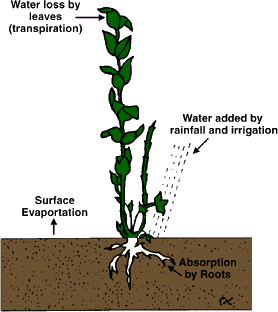 TX CES Efficient Use of Water in the Garden and Landscape
TX CES Efficient Use of Water in the Garden and Landscape
Evapotranspiration is dictated by various types of factors:
- Climate: rainfall, sunlight, wind, humidity, temperature
- Soil: soil type, mulch cover
- Plant: species, stage of growth
- Landscape: planting density, microclimate
Climate factors
Effective rainfall
Not all rain is available to plants. Some is lost through runoff or deep percolation. Effective rain is the portion remaining in the root zone. Rainfall capture depends both on rain quantity and on site-specific factors: soil type, slope, foliage canopy, storm intensity and duration, and the initial soil water content.
Evapotranspiration
Evapotranspiration is the loss of water to the atmosphere from the landscape. Evaporation loss occurs from wet leaf or soil surfaces, while transpiration loss occurs through leaf pores (stomata) and is an active plant process analogous to sweating. Note that when the soil surface is covered by vegetation or mulch, only 1–3% of evapotranspiration loss is due to evaporation.
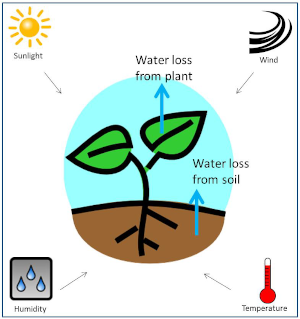 Agriculture Victoria What is evapotranspiration and how do I use it to schedule irrigation?
Agriculture Victoria What is evapotranspiration and how do I use it to schedule irrigation?
Evapotranspiration is determined by:
- solar radiation (hours of sunshine & sunlight strength, which depend on altitude, latitude & the season)
- air temperature
- humidity
- wind speed
- soil heat flux (to standardize, assumes a model surface that mimics a dense stand of turfgrass of defined height)
Potential evapotranspiration (ETo) represents the loss of water when the soil is fully charged with water.
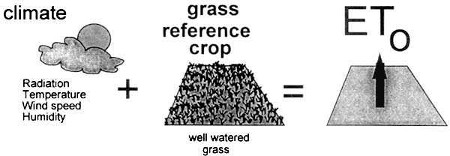 United Nations Food & Agriculture Organization Introduction to evapotranspiration
United Nations Food & Agriculture Organization Introduction to evapotranspiration
Species (crop) factor
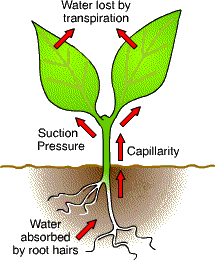 USDA, NSF Transpiration: Water Movement Through Plants
USDA, NSF Transpiration: Water Movement Through Plants
Turfgrass evapotranspiration is used as the reference and is assigned a value of 1. All other species are assigned a correction factor (the crop factor) that adjusts the ETo to reflect empirically determined species water use over the growing season, accounting for leaf surface and state of growth, and applies regardless of vegetation type (tree, shrub, groundcover, vine or herbaceous). The water needs of ornamental species relative to the reference ETo are classified into four groups, from very low to high.
| Water Need | Species Factor |
|---|---|
| Very Low | ‹0.1 |
| Low | 0.1–0.3 |
| Moderate | 0.4–0.6 |
| High | 0.7–0.9 |
| Turfgrass | 1 |
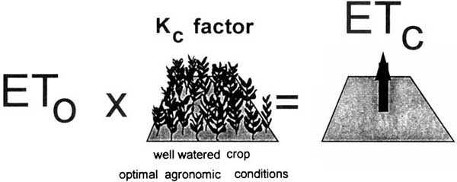 United Nations Food & Agriculture Organization Introduction to evapotranspiration
United Nations Food & Agriculture Organization Introduction to evapotranspiration
Landscape factors
Vegetation density
Denser plantings have more total leaf surface and thus lose more water. Planting density can alter landscape water need by as much as 2.6-fold. Note that evaporation from soil is negligible when it is properly mulched, but bare soil will increase water loss from a landscape by 10–20%.
Microclimate
Microclimates in a home landscape can range from cool, shaded, protected areas to hot, sunny, windy areas and can alter plant water loss by as much as 2.8-fold. Buildings and paving influence temperature, wind speed, light intensity, and humidity. Plantings that are shaded for a substantial part of the day or are protected from wind experience the least loss. These areas include the north side of buildings, courtyards, areas under building overhangs or shaded by trees for much of the day, and the north side of slopes. Conversely, plantings located adjacent to south or southwest facing walls, in wind tunnel locations, receiving reflected light from nearby windows or cars or next to heat-absorbing surfaces like concrete, asphalt, brick or stone will lose more water than average.
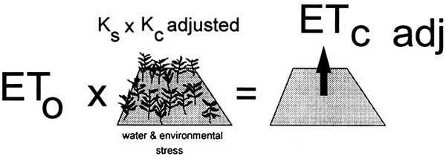 United Nations Food & Agriculture Organization Introduction to evapotranspiration
United Nations Food & Agriculture Organization Introduction to evapotranspiration
Soil
For maximum plant growth and crop yield, irrigation should create and maintain soil that is fully charged with moisture, but with air-filled pores like a wrung-out spunge. This condition is called field capacity. Field capacity is the water held by soil when medium pores are maximally charged with water but gravitational pores are empty. This is the water remaining in a soil after it has been thoroughly saturated and allowed to drain freely for one to two days.”}. Soil explains why structure is so critical for efficient water use and gives detailed instructions on how to create your own WaterWise soil.
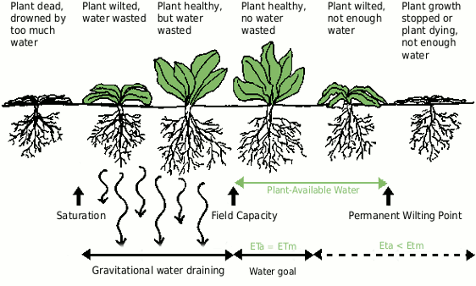 ET~a~, actual evapotranspiration; ET~m~, maximum evapotranspiration
ET~a~, actual evapotranspiration; ET~m~, maximum evapotranspiration
modified from New Zealand Digital Library Food from dryland gardens
Irrigation need
Total available water is the median available water capacity of the soil × the median depth of the surface soil layer. The equation starts with soil fully charged with water and monitors daily water depletion due to evapotranspiration, recommending irrigation once the soil reaches 50% depletion. Allowable depletion is 50% because even when the soil texture is uniform and moisture is consistent throughout, plant roots are not uniformly distributed in the root zone.
frequency
The basic equation for watering frequency (days) is:
effective root zone
Even when the soil texture is uniform and moisture is consistent throughout, plant roots are not uniformly distributed in the root zone. The usual pattern is ~ 40% of roots in the upper quarter of the root zone, 30% in the second quarter, 20% in the third quarter, and 10% in the bottom quarter. Thus, 70% of plant moisture need is obtained from the upper half of the root zone, defined as the effective root zone.
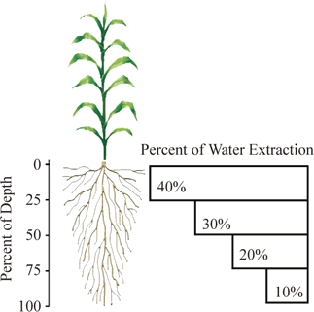 NE CES Irrigation management for corn
NE CES Irrigation management for corn
When the available water in a loam soil is depleted by 50%, the area responsible for 70% of plant water uptake is wholly depleted and plants begin to exhibit drought stress. Thus, 50% depletion is considered the point where irrigation is required. For clay, drought stress begins at only 25% depletion of available water.
What plants will perform well here?
What is the balance between Orange County rainfall and plant water needs? Our rainfall during the growing season is erratic and only some plant species will work well here without supplemental irrigation. To look only at water loss due to plant evapotranspiration we assume:
- mulch is used to reduce water evaporation from the soil
- plants are grown in standard sun conditions, unimpeded by shade or root competition from nearby vegetation
Calculation
We use spatially averaged daily precipitation and evapotranspiration data for the 60-year period 1950 – 2009 for Orange County. We factor in county averages for soil moisture level, soil depth, and available water capacity plus the effective root zone depth of the plant in question.
- It is customary to apply a margin of safety to this type of calculation, so for precipitation quantity we use dependable rain — the amount that has an 80% chance of occurrence.
- We use 50% depletion of soil water as the point at which irrigation would be needed to maintain a healthy, esthetically acceptable plant.
- We use spatially averaged daily rainfall values for the 60-year period 1/1/1950-12/31/2009 and a daily water balance model of effective rain that accounts for soil water content in the root zone but does not reflect soil permeability and so can overestimate the water captured during intense storms.
- Our soil factors are countywide medians of soil type, slope, initial water content, depth (8.55 inches), and plant-available water capacity (0.16 inch/inch of soil depth). These are representative of our native gardenable topsoils (wetlands and very steep slopes are excluded) and use only the surface soil (A horizon).
- Daily ETa values are from area stations (corrected for differences in instrumentation between stations) interpolated for Orange County for the 60–year period 1/1/1950 - 12/31/2009. We thank Heather Dinon from the State Climate Office of NC for her gracious provision of evapotranspiration data and generous, insightful discussions of instrumentation and contributing variables.
Data
The graph below is specific to Orange County. It shows how much plant-available water is present in the root zone by computing, on a daily basis, how much water is likely to be added through dependable rainfall and how much water is likely to be lost due to evapotranspiration.
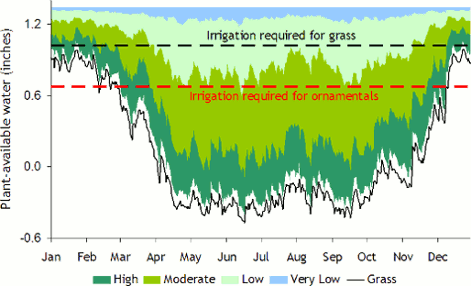
- Species groups are defined by water need (very low–high) and are shown as blocks of color in the graph, while grass is shown as a solid black line.
- A species group needs irrigation when its color band dips below the red dashed line.
- Grass (the black line below the other color bands) needs irrigation when it dips below the black dashed line.
The bottom line is that to achieve an irrigation-independent landscape you should:
- minimize your lawn area
- use plants with a low or very low species factor
- encourage a deep root system
Organic amendments shift conditions
The graph below shows what happens if the available water capacity of our native soil is doubled by the liberal addition of compost.
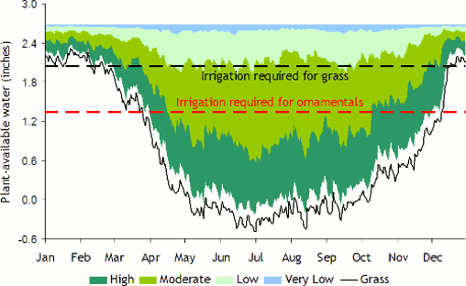
- Turfgrass still requires regular water during the growing season.
- However, now only a thirstier subset of moderate-need plants (the lime green band), require irrigation during the growing season. There is an 80% likelihood that more than half of the moderate-need species will be fine with no supplemental water. Note that the scale of the Y axis has changed.
